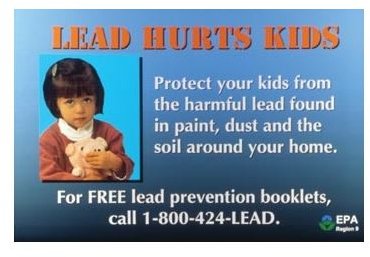Prevention and Symptoms of Lead Poisoning
Symptoms
Lead is absorbed into the blood from the respiratory tract (inhaled) or the intestinal tract (ingested) and is normally stored in the bones as an inactive form. Excess lead is deposited in soft tissues, causing damage primarily to the blood, kidneys, and nervous system.
Lead is extremely toxic to red blood cells, resulting in anemia, one of the initial symptoms of lead poisoning.
Lead injures the cells of the proximal tubules, resulting in abnormal excretion of glucose, protein, amino acids, and phosphate from the kidneys.
The most serious and irreversible symptoms are on the nervous system. Initially, behavioral changes occur, including hyperactivity, aggression, impulsiveness, lethargy, irritability, clumsiness, learning difficulties, and short attention span. As toxic damage to the brain progresses, more serious complications develop, including convulsions, mental retardation, paralysis, blindness, and death.
Other vague symptoms of lead poisoning include vomiting, acute crampy abdominal pain, constipation, headache, loss of appetite, weight loss, and fever.
Prevention of Lead Poisoning
Young children are particularly at risk for lead poisoning because they like to explore their environment by putting objects into their mouths.
Lead Paint
Lead paint is a major cause of lead poisoning. Before 1960, almost all household paints contained high levels of lead and before 1978, lead was still a common ingredient in paint but in lesser amounts. A few chips of paint may contain several hundred times the amount of lead considered safe to ingest.
Remove all lead paint from your home (do not allow children in the home until the project is completed). Hire a professional if you are unsure how to remove it safely. Covering leaded paint with a lead-free paint or with wallpaper reduces the hazard but it still puts one at risk of lead poisoning.
Be aware of other old buildings, such as schools or day care centers.
Before 1978, lead paint was also used for household furniture and children’s toys.
Pipes
Plumbing systems, before the 1980s, can contain lead from lead pipes and pipes soldered with lead. Until these pipes can be replaced, do the following to help in the prevention of lead poisoning:
- run cold water for 30-60 seconds before drinking or cooking
- do not use the hot water for drinking or cooking.
Soil
Over the years, soil has accumulated large amounts of lead, especially along heavily trafficked roadways. Avoid letting children play in high risk areas and wash fruits and vegetables thoroughly to wash off any lead if present.
Dust
Household dust from soil brought into the house and from paint chips is another big concern. Dust can be inhaled or it can be ingested through hand/object-to-mouth contact.
Other
Other sources of lead include plaster, caulking, glazed pottery, cigarette butts and ashes, colored newsprint, painted food wrappers, curtain weights, lead figurines, lead sinkers used for fishing, automobile exhaust, cigarette smoke, and contaminated clothing and skin of individuals working in high risk environments such as smelting factories, firing ranges, and automobile repair shops (if you work around a source of lead, remove your clothes and shoes as soon as possible at home).
Washing hands often and staying well nourished (the body absorbs less lead) can also help in the prevention of lead poisoning.
Have your child tested for lead, especially if they are at risk or if they have symptoms of lead poisoning.
Disclaimer
Please read this disclaimer regarding the information contained within this article.
